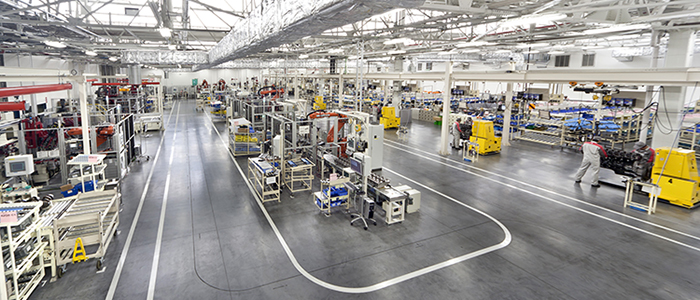Clean production
The three main environmental activities in production and logistics are: the reduction of energy consumption (CO2 emission), the reduction of waste and the reduction of environmentally hazardous substances. A review of systems and infrastructure has been made at UD Trucks plants in Japan in order to reduce CO2 emissions, the recycling and reduction of wastes destined for final disposal, and the proper management of chemical substances, in compliance with all laws and regulations.

Use of energy and emission of CO2
In 2011, the Volvo Group became the first automotive manufacturer to join in the WWF’s Climate Savers program. The group pledges to reduce CO2 emissions from its factories by 500,000 tons by the year 2014.UD Trucks has also established a strong track record in actual achievements. The company more than achieved a goal to reduce 1990 levels of CO2 emission by 31% by 2012. In fact, it realized a reduction of 60.8%—but also realized that there will be a further challenge ahead as production increases in the future.
Its activities include a number of energy-saving initiatives, part of a process overseen by an all-company Energy-Saving Promotion Committee:
- The introduction of large-scale natural gas cogeneration equipment
- The changeover to energy-saving equipment, including energy-saving transformers and inverter-type florescent lamps
- Conversion to LED and high-efficiency mercury lighting
- The introduction and expansion of demand surveillance systems and energy management systems
- Optimized operation of air compressor control equipment, including inverter control
- Optimization of the operation hours of plant facilities
- Efforts for improvements in air and steam leakage and adjustment of lighting to reduce unneeded illumination
Waste management
As part of our effort to lessen environmental impact, UD Trucks is actively engaged in the reduction of waste materials. The goal is to reduce the amount of materials that are destined for final disposal through the reduction of waste materials generated as well as recycling to the highest degree possible. In 2012, the reuse of incinerator residue and separation of refuse materials was part of educational activities aimed at the recycling of resources and the reduction of waste materials created. The result was a 99.9% reduction of the amount of waste destined for final disposal, compared to the figure for 1990.With a recycling rate of more than 99%, the company can now say that it is zero emission*. UD Trucks will continue to work to make a true recycling-oriented society possible and continue its waste-recycling activities.
*At UD Trucks, we define a recycling rate of greater than 99% as effectively zero emissions.
Use of chemicals
To reduce the risks of environmental pollution and damage caused by chemical substances, UD Trucks has implemented registration and management standards for chemicals and other similar materials. These include a pre-assessment of chemicals, activities to prevent pollution and accidents and plans for the proper management of chemical wastes. Based on Japan’s Pollution Release and Transfer Register (PRTR) system, which is considered Japanese version of the EU REACH (Registration, Evaluation, Authorization and Restriction of Chemicals), an inspection is made each year on all materials purchased.As part of the 2012 efforts for the reduction of emissions, we abolished use of the white gasoline in which a PRTR listed substance is contained. UD Trucks continues to work to accelerate the change to safer materials, and continues to reduce releases to the environment of specific chemical substances including VOCs (volatile organic compounds).
